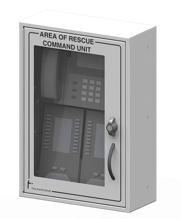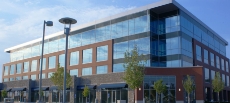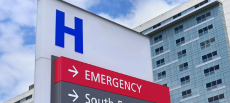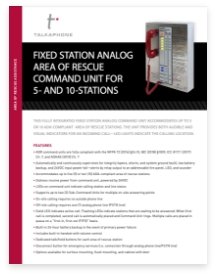 Advances in modern technology continue to improve how we interact with each other and the world around us. We continue to see the development of better ways to complete both individual and organizational tasks faster and more efficiently with new or upgraded technologies. As old concepts take new shape, archaic systems and products are replaced with more advanced versions. And, many new technologies that were originally designed for one application are beginning to cross over into new areas. Following suit, security technologies offer several new options and capabilities that go beyond the typical uses in traditional applications.
Advances in modern technology continue to improve how we interact with each other and the world around us. We continue to see the development of better ways to complete both individual and organizational tasks faster and more efficiently with new or upgraded technologies. As old concepts take new shape, archaic systems and products are replaced with more advanced versions. And, many new technologies that were originally designed for one application are beginning to cross over into new areas. Following suit, security technologies offer several new options and capabilities that go beyond the typical uses in traditional applications.
In its May article, “Mass Notification Serves Notice of More Uses,” Security Sales & Integration Magazine discusses alternative ways emergency communications platforms are being leveraged to achieve business efficiencies.
Integrators who embrace the chance to extend security technology into new applications and approach new business opportunities with an open mind will position themselves as cutting edge solutions providers. Bringing together two technologies to complete a robust, full-service solution that offers more than just security for the end user is not only possible, but also becoming increasingly desired.
A mass notification system’s primary objective is to disseminate one-way communication to individuals or groups of individuals in the event of an emergency. They provide the fastest way to deliver a message to the masses when a crisis situation arises. However, with advancements in software technology and successful systems integration, mass notification systems have taken on a much broader scope of functionality. In addition to having the ability to send an intelligible audio broadcast to an enabled security communication device, new mass notification technology is making it possible for organizations to establish two-way communication to improve both internal and external operational processes. Additionally, recent changes made to the NFPA 72 2010 make it possible for emergency communication systems to broadcast informational messages.
 Three delivery models for a mass notification platform are available, including hosted software, on-premise or a hybrid of the two. While all three models make it easy to send thousands of notifications through text messages, e-mails, landline phones, pagers, fax and BlackBerry Messenger, the future looks especially bright for the cloud-based version that is available as a software-as-a-service (SaaS). The hosted application is available off-site where users can gain instant access to send alerts from a mobile or Web app through real-time connectivity to the Internet. The hosted platform requires no hardware or software installation.
Three delivery models for a mass notification platform are available, including hosted software, on-premise or a hybrid of the two. While all three models make it easy to send thousands of notifications through text messages, e-mails, landline phones, pagers, fax and BlackBerry Messenger, the future looks especially bright for the cloud-based version that is available as a software-as-a-service (SaaS). The hosted application is available off-site where users can gain instant access to send alerts from a mobile or Web app through real-time connectivity to the Internet. The hosted platform requires no hardware or software installation.
The new mass notification technology is empowering corporations, educational institutions and government agencies with new ways to use their existing communication tools beyond typical security functions. Let’s explore some of the creative ways notification platforms are helping organizations across a wide range of industries boost efficiency and improve operational functions.
Improving patient care with mass notification
A recent study shows that the need for improved security among hospitals is on the rise. According to the International Association for Healthcare Security and Safety (IAHSS), 98% of healthcare facilities experience violence and criminal incidences. With long hours of operation, a large number of buildings to manage and a rising vulnerability to criminal activity, these organizations face unique challenges when it comes to security.
At the same time, while the need for improved security solutions among healthcare facilities becomes increasingly critical, communication within these organizations is also an area leaving room for improvement. At first glance, these two problems might appear to be unrelated. However, new mass notification software technology can help with both.
 While a mass notification platform allows hospitals to quickly send both emergency messages and general announcements to patients and staff through any security communication device on campus, they are also integrating the software into their communication systems to help manage staffing changes, generate revenue, use time more efficiently, and improve the quality of patient care.
While a mass notification platform allows hospitals to quickly send both emergency messages and general announcements to patients and staff through any security communication device on campus, they are also integrating the software into their communication systems to help manage staffing changes, generate revenue, use time more efficiently, and improve the quality of patient care.
The mission statement behind every healthcare organization uniquely defines the group’s visions for providing the best possible patient care. In the case of one hospital, the absence of a mass notification system made managing the ratio of staff to patients a time-consuming and inefficient task. The process forced nurses to leave their patients for extended periods of time. For example, when a nurse called in sick to work, it became the job of another nurse to begin the daunting task of manually dialing the telephone to look for substitutes.
After the installation of notification software, a multi-department meeting helped the staff members come up with creative ways to use the technology to streamline many day-to-day processes. Because the software now allows the nurses to send an alert to several people on a variety of communication devices, the problem of finding substitute nurses is quickly resolved. Everyone receives the message at the same time and has an equal opportunity to respond.
The same hospital is also using the mass notification software to increase annual revenue. In the event of an accident, the ability to quickly pull surgical teams together for emergency operations is made possible with a mass notification platform. If the hospital needs to reach surgeons specializing in different areas, one quick alert delivered by SMS, e-mail or phone call can make the difference in gaining the needed team members or missing out on an opportunity. The team members can respond with a quick message notifying the right people when they will arrive.
Mass transit facilities and notification technology
Mass transit systems include inner city buses, trolleybuses, subway and commuter rail, heavy and light rail, automated guideway transit, cable cars and monorails. Combined, these systems provide over 9.6 billion trips per year. Amtrak alone serves 21 million passengers per year at more than 500 stations.
 To enhance security within all mass transit locations, the TSA focuses on five strategic priority principles in the implementation of mass transit and passenger rail safety. According to the agency’s website, the first of those principles is to “expand partnerships for security enhancement.” One way some mass transit agencies are using this principle is with the integration of mass notification technology.
To enhance security within all mass transit locations, the TSA focuses on five strategic priority principles in the implementation of mass transit and passenger rail safety. According to the agency’s website, the first of those principles is to “expand partnerships for security enhancement.” One way some mass transit agencies are using this principle is with the integration of mass notification technology.
With a notification platform, mass transit facilities have the ability to deliver intelligible audio messages through WEBS (wide area emergency broadcasting systems) to passengers based on geographical location. The software allows messages to be sent to a specific train, platform or an entire station.
To help facilitate communication with passengers, rail services are also using mass notification technology integrated with PA systems to send messages regarding delayed train departures, delayed train arrivals, possible accidents, and other information that will impact their traveling plans.
Optimizing employee productivity with mass notification
A mass notification platform can be used within all departments of a business to improve internal communication for improved business continuity, including in the areas of sales and marketing, facilities, and IT.
On the sales and marketing side, mass notification allows upper management to initiate instant conference calls. Today’s businesses are growing into more global enterprises with employees scattered across the world and oftentimes e-mails or traditional conference bridges are not efficient ways to communicate with team members. For one reason or another, it’s not always possible to get everyone to join a call intended for the entire group, resulting in a breakdown of productive correspondence. The option to integrate mass notification software into a customer relationship management (CRM) system makes it possible for sales directors to send team members a meeting alert and for the recipients to join the call right away by pressing a button on their phone. Delivery confirmation is a reliable feature that informs the original sender when the alert has been received or if it had been neglected on purpose.
Mass notification is also a reliable way to keep employees briefed on pertinent information regarding major organizational restructuring. To keep employees productive, one large company used a notification platform to communicate with employees about the latest developments during a merger and to answer common questions regarding changing job functions and stability. With so many dispersed employees scattered across the world, the corporate sponsored messages were sent out instantly through landline phones, SMS, and e-mails. The company’s CEO was able to tailor the messages to answer employee concerns regarding the acquisition and then easily track the responses.

There are several ways notification technology is helping facilities departments within organizations function more efficiently. Many businesses are using notification platforms to keep everyone informed about inclement weather and possible natural disasters. The technology not only allows the message to be delivered to thousands of employees at once, it also provides a way for them to respond with important information. For example, if a storm has caused a power outage in the building, an employee who has already reported to work can respond with information about the status of the situation. Similarly, facilities departments can easily inform the entire staff with updates about ongoing maintenance projects, parking closures and other situations that have a direct impact on everyone in the building.
Mass notification improves operational processes
Mass notification platforms help improve business operations in several unique ways. With the software in place, alerts and notifications can be sent straight to distributors and vendors right away. For example, when pricing changes or special new product introductions come up, the platform makes it possible to streamline communication to keep all key partners in the loop.
Integrating mass notification into CRM systems is an efficient way to send polls and surveys to segmented customer lists. The new platform allows recipients to respond to questions in a variety of ways that are beneficial to the business and convenient for the recipient. For example, recipients can respond to questions by voice or by written messages. All data is saved and made available for e-mailing or texting in full reports to any recipient the sender chooses.
The platform’s call cascade feature provides a way for marketing teams to gain useful feedback from clients or potential customers. A message can be sent out to a large group and based on the response, senders can ask more specific questions to get more specific information. This feature is also beneficial in the case of a natural disaster or emergency. The ability to automate wider alerts based on a recipient’s responses helps authorities gain information and manage the situation.
Robust data centers monitor IT systems, alert staff
At the IT level, events affecting data security and network outages can be sent to the appropriate staff members immediately before they cause downtime or delays. The integration of data monitoring software into mass notification platforms eliminates the need for a business’s IT staff members to monitor processes and systems. In the event of an issue, the notification platform will automatically send IT an alert so the employee on duty can quickly fix the existing problem. With multiple data centers located around the world, the platform’s monitoring process is robust and reliable.
Within a business, automatic reminders can be set up in advance on behalf of the Help Desk team members to cut down on expiring passwords and reset issues among company employees.
Mass notification in government agencies
 Government agencies ranging from the Federal Government down to local municipalities are using mass notification systems to minimize costs and improve efficiencies in several ways.
Government agencies ranging from the Federal Government down to local municipalities are using mass notification systems to minimize costs and improve efficiencies in several ways.
After the workers at one local municipality were forced to walk door-to-door to personally deliver the message of contaminated water to each resident, city officials discovered the need for a way to improve its communication with members of the city. After the integration of mass notification software, the city officials were able to reach residents with one quick message by text, e-mail or phone call.
Additionally, fire departments use the platforms to notify residents of emergencies and also to communicate internally when it comes to filling open shifts.
Mass notification at colleges and universities
Colleges and universities embraced mass notification technology early on as a way to send out emergency messages to students, staff and visitors on campus. Emergency communication systems aren’t just for emergencies anymore. In fact, many colleges and universities rely on mass notification to streamline day-to-day communications.
Mass notification platforms are being used on campuses to alert faculty members about a meeting update; alert students if a class venue has changed, remind them of approaching or shifting deadlines, special events or a change in office hours.
When storms hit, colleges are also using notification to inform students about canceled classes or building closures caused by unsafe conditions, flooded parking lots and power outages.
Personal notification technology is also helping college officials reach students, staff and visitors who are part of an updated database through text messages, e-mails, and social networks.
Conclusion
There are several more ways mass notification software has helped improve productivity and operational processes for businesses within a growing number of industries. We will continue to see the rise of mass notification technologies in new spaces, resulting in increased opportunities for integration beyond traditional security applications.







